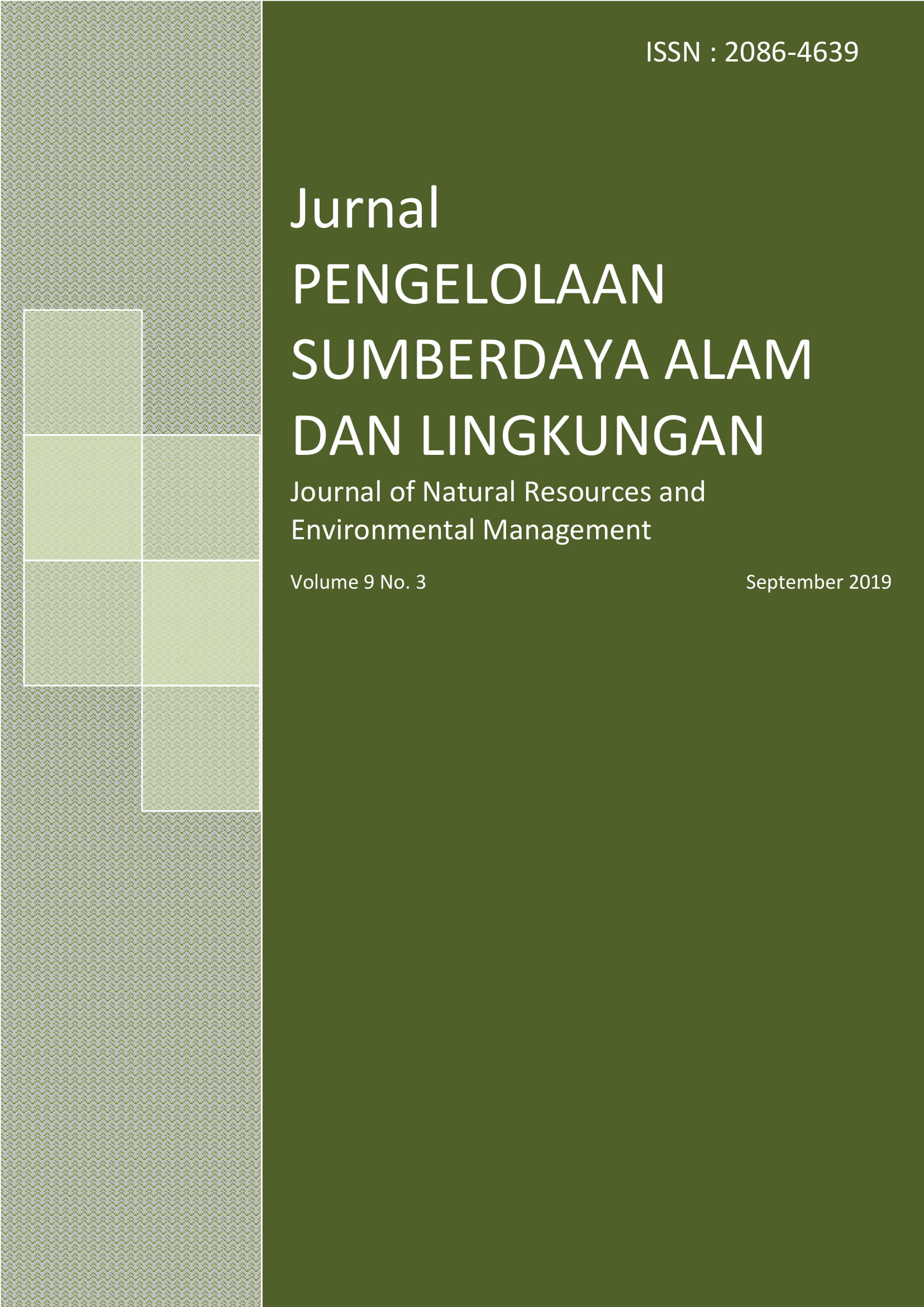Spatial Distribution Of Andaliman Potential Habitat (Zanthoxylum acanthopodium DC.) in Samosir Island, North Sumatera
Abstract
Full text article
References
Beaumont R. 2012. An introduction to Principal Component Analysis & Factor Analysis Using SPSS 19 and R (psych package). Diunduh 10 Mei 2018. http://www.floppybunny.org/robin/web/virtualclassroom/stats/statistics2/pca1.pdf.
Bleher B, Oberrath R, Böhning-Gaese K. 2002. Seed dispersal, breeding system, tree density and the spatial pattern of trees – a simulation approach. Basic Appl. Ecol. 3:115–123.
Dermawan BA. 2017. Prediksi Sebaran Invasif Spesies Acacia nilotica Dengan Model Maximum Entropy (Studi Kasus Taman Nasional Baluran). [tesis]. Bogor: Sekolah Pascasarjana, Institut Pertanian.
Febrianti N, Sofan P. 2014. Ruang terbuka hijau di DKI Jakarta berdasarkan analisis spasial dan spektral data Landsat 8. Bidang Lingkungan dan Mitigasi Bencana. LAPAN: Pusfatja.
Hartley TG. 1966. A revision of the Malesian species of Zanthoxylum (Rutaceae). J. Arnold Arboretum. 47:171–221.
Hasairin A. 1994. Etnobotani Tumbuhan Rempah dalam Makanan Adat Masyarakat Batak Angkola dan Mandailing [tesis]. Bogor: Program Pascasarjana IPB.
Hasan. 2012. Pemodelan Spasial Sebaran dan Kesesuaian Habitat Spesies Tumbuhan Asing Invasif Kirinyuh (Austroeupatorium inulifolium (Kunth) R. M. King & H. Rob) di Resort Mandalawangi Taman Nasional Gunung Gede Pangrango. [tesis]. Bogor: Sekolah Pascasarjana, Institut Pertanian Bogor.
Jongjitvimol T, Boontawon K, Wattanachaiyingcharoen W, Deowanish S. 2005. Nest Dispersion of a Stingless Bee Species, Trigona Collina Smith, 1857 (Apidae, Meliponinae) In A Mixed Deciduous Forest in Thailand. The Natural History Journal of Chulalongkorn University. 5(2): 69-71.
Kokilavani V, Narayanan A. 2018. Zanthoxylum acanthopodium DC.. [online] India Biodiversity Portal, Species Page 3: Zanthoxylum acanthopodium. Davailable at: https://indiabiodiversity.org/biodiv/species/show/280529 [Accessed date Sep 4, 2018].
Kokutse NK, Temgoua AGT, Kavazovic´ Z. 2016. Slope stability and vegetation: Conceptual and numerical investigation of mechanical effects. Ecological Engineering. 86:146–153. http://dx.doi.org/10.1016/j.ecoleng.2015.11.005.
Leps J, Kindlmann P. 1987. Models of the development of spatial pattern of an even-aged plant population over time. Ecol. Modelling. 39: 45-57.
Odum EP. 1993. Dasar-Dasar Ekologi. Tj. Samigan. penerjemah; Srigandono, editor. Yogyakarta: Gajah Mada Press. Terjemahan dari: Fundamental of Ecology Ed ke-3.
Rakić T, Šinžar-Sekulić J, Filipović B, Tadić V, Stevanović B, Tan K. 2009. Ecophysiological and Anatomical Characteristics of the Subtropical Shrub Zanthoxylum acanthopodium (Rutaceae) in Conditions of a Temperate Continental Climate (Serbia). Arch. Biol. Sci. Belgrade 61(2): 249-260. DOI:10.2298/ABS0901249R.
Rikimaru A, Roy PS, Miyatake S. 2002. Tropical forest cover density mapping. Trop. Ecology. 43: 39–47.
Soerianegara I, Indrawan A. 2008. Ekologi Hutan Indonesia. Laboratorium Ekologi Hutan. Bogor : Institut Pertanian Bogor.
Suzuki RO, Jun-Ichirou S, Kachi N. 2005. Change in Spatial Distribution Patterns of a Biennial Plant between Growth Stages and Generations in a Patchy Habitat. Annals of Botany. 96: 1009–1017. doi:10.1093/aob/mci253.
Syartinilia dan Tsuyuki S. 2008. GIS-based modeling of Javan Hawk-Eagle distribution using logistic and autologistic regression models. Biological Conservation. 141: 756-769.
Tensiska. 2001. Aktivitas antioksidan ekstrak buah andaliman dalam beberapa sistem pangan dan kestabilan aktivitasnya terhadap kondisi suhu dan pH [tesis]. Bogor: Sekolah Pascasarjana, Institut Pertanian Bogor.
Wijaya CH. 1999. Andaliman, rempah tradisional Sumatera Utara dengan Antioksidan dan Antimikroba. Teknologi dan Industri Pangan. 2(10): 59-61.
Yonzone R S, Rai. 2016. Zanthoxylum Acanthopodium DC. (Rutaceae) - a favourable ethnomedicinal fruit for the local inhabitants of Darjeeling Himalaya of West Bengal, India. J Complement Med Alt Healthcare. 1(1): 555554.
Authors
Authors who publish with this journal agree to the following terms:
- Authors retain copyright and grant the journal right of first publication with the work simultaneously licensed under a Creative Commons Attribution License that allows others to share the work with an acknowledgement of the work's authorship and initial publication in this journal.
- Authors are able to enter into separate, additional contractual arrangements for the non-exclusive distribution of the journal's published version of the work (e.g., post it to an institutional repository or publish it in a book), with an acknowledgement of its initial publication in this journal.
- Authors are permitted and encouraged to post their work online (e.g., in institutional repositories or on their website) prior to and during the submission process, as it can lead to productive exchanges, as well as earlier and greater citation of published work (See The Effect of Open Access).





